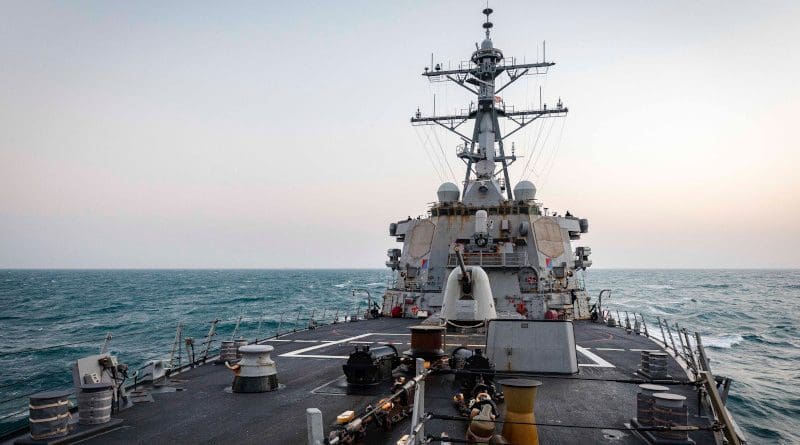US Engagement In South China Sea: Beyond FONOPS And Into ‘Grey Zone’ – Analysis
By IPCS
By Janhavi Pande*
The April 2021 standoff between the Philippines and China’s maritime militia in and around the Whitsun Reef in the South China Sea (SCS) is just one example of China clashing with a claimant state in the region. With the growth of Beijing’s national power, and its deteriorating ties with the US and its regional allies, the SCS dispute has become increasingly intractable.
Real-time US engagement in the SCS has been largely limited to its Freedom of Navigation Operations (FONOPS). There is minimal engagement with the asymmetric tools or ‘grey zone tactics’ China deploys for the assertion of its sovereignty over the sea. Indeed, the maritime militia is among its most important assets. For the US to be able to successfully deter China, it is the challenge of this militia that it will have to ultimately confront.
Understanding China’s Naval Militia
Known as the People’s Armed Forces Maritime Militia (PAFMM), China’s naval militia is composed of civilian fishermen trained and operated under the direct control of the People’s Liberation Army (PLA). The only other country with a fishing militia is Vietnam, which has developed its force in response to China’s use of what is effectively an army of insurgent maritime vessels. The use of such militia is also peculiar to the region and without precedent. Consequently, defining its precise character as either a civilian or military object is a challenge.
The PAFMM helps enforce China’s maritime claims and is now also a tool for low-level hostilities and access denial against US vessels in the region. It is deployed in a way that makes resorting to retaliatory force difficult. Additionally, Chinese fishing boats have frequently been accused of indulging in indiscriminate deep sea fishing, well beyond the SCS. This makes the PAFMM even more threatening given its propensity to exploit global commons without hindrance. From the point of view of US strategy, the PAFMM is a formidable challenge that is yet to be addressed beyond the official discourse around “grey zone” warfare.
Nature of US Engagement
The US’ primary engagement in the SCS has been via the FONOPs which began under the Reagan administration. They are now being used to challenge China’s excessive claims to the SCS. The problem with FONOPs is that they don’t address the core problem of China’s salami slicing strategy. They are aimed instead at all countries with excessive claims and restrictions on access to Exclusive Economic Zones (EEZ).
China’s ability to use control-gaining tactics that fall just below the threshold of an outright war is at the heart of the regional quagmire. This ability is only somewhat matched by the Vietnamese. Given Beijing’s economic muscle, no other claimant is in a position to challenge this slow and steady ‘sovereignty grab.’ To effectively address China in the SCS will involve challenging the assets it employs to establish de facto presence in, and dominance of, disputed waters.
Case for More Proactive US Engagement
The US has indicated that it may treat the PAFMM as part of the Chinese armed forces. The question is whether the current Biden administration is actually willing to take that step. The pandemic has considerably weakened the US economy and called into question even its domestic governance systems.
So far, the new administration has made the right noises on the Indo-Pacific. It has attempted to reestablish US goodwill in the region through a relatively open framework for the Quad and active engagement with its allies. However, the time to act in the SCS is running out as President Xi Jinping has long gone back on his promise of not militarising the sea. The longer it takes to sanction the PAFMM, the more confidence it gives Beijing to control large portions of the maritime space without any deterrence.
The US cannot intervene militarily after China has established effective control. This could be construed as interventionism and disproportionate ‘use of force’, risking miscalculations. It would also, in all probability, not be welcomed by members of the ASEAN who have thrived around maintaining a delicate peace with China, and don’t want to be dragged into a high-intensity great-power rivalry.
Some analysts have already argued that the US should begin using its Coast Guard forces to counter the asymmetry. Even if this isn’t an immediate possibility, the US needs to categorically identify the PAFMM’s legal status instead of using euphemistic terminology. It must characterise PAFMM deployment as both threat and use of force under Article 2(4) of the UN Charter. One, this would give the US navy itself a clearer picture of how it needs to act in the event of an attack by the militia and Chinese Coast Guard ships. Second, it sends a more decisive but less interventionist signal about US intent in the region.
Another option would be to legally challenge China’s distant water fishing, which is the largest of its kind, through international resolutions, and allow entry of Chinese vessels into its maritime zones on the basis of strict reciprocity.
Conclusion
For decades now, the PAFMM has been crucial to China’s construction of sovereignty in the SCS. Without a US presence in the region, the SCS effectively becomes a Chinese lake, allowing Beijing to project power in the Indo-Pacific. For Washington to be able to maintain a balance of power in the region, it must be willing to challenge the validity and centrality of this very nebulous ‘reserve force’ in both letter and spirit.
*Jahnavi Pande is a Research Intern with IPCS’ South East Asia Research Programme (SEARP).

